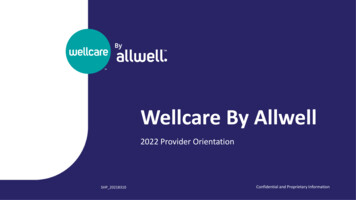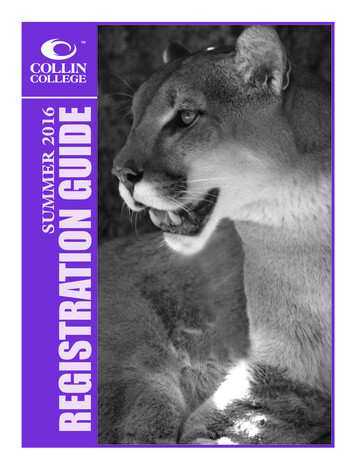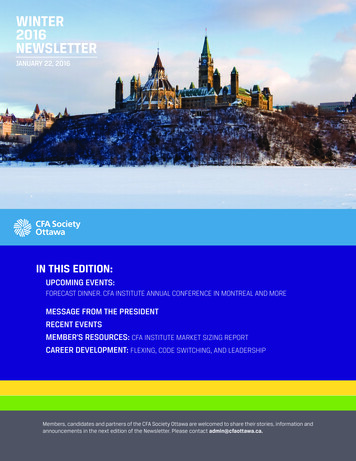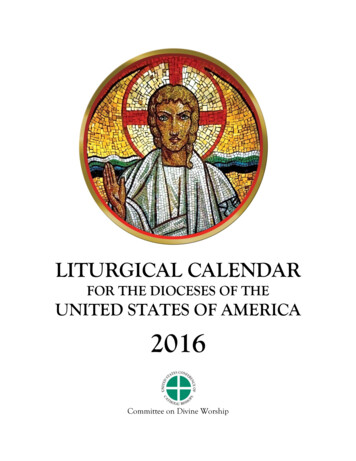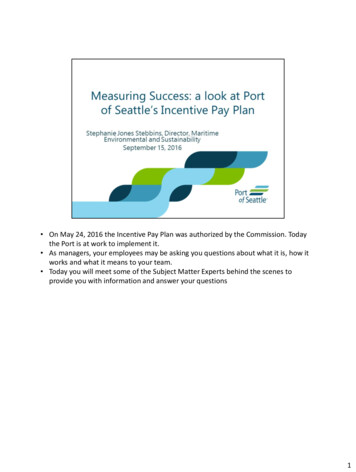
Transcription
On May 24, 2016 the Incentive Pay Plan was authorized by the Commission. Todaythe Port is at work to implement it. As managers, your employees may be asking you questions about what it is, how itworks and what it means to your team. Today you will meet some of the Subject Matter Experts behind the scenes toprovide you with information and answer your questions1
Washington’s ports are municipal corporations, that is special purposegovernments. We are a separate agency, not part of the state, county nor city. Our jurisdiction is King County. King County citizens vote for the fivecommissioners. The Commissioners hire the Chief Executive Officer, who is responsible forthe day to day operations of the Port. Because we were not deeded land by the city or state when the Port wasestablished, we levy a tax on the property owners of King County. Wepurchase property at full market value to expand our facilities. The Port reduced the amount of its tax levy from 75.9 million to 73.5million for the first time since 1991. 2012 tax levy will raise 73.0 million – just over 23 cents on the tax dollarpaid to King County – to be used for bond debt service, freight mobility,Seaport and Real Estate environmental projects, capital improvements, Officeof Port Jobs. The five-year capital improvement program is 1.5 billion, which reflects thePort’s continuing commitment to promoting regional economic activitythrough the investment in the development, expansion and renewal of Portfacilities that supports the Port’s Business Plan and Green Initiative.8/2/122
Diverse Port; one of the few ports that operates both an airport and a seaport4 container terminals, 2 cruise terminals, 3 recreational boat marinas, airport, grainterminal, fisherman’s terminal, world trade center, and an international conferencecenter22 parks and public access areas.Updated 3/26/103
4
Financial Goal ensures the plan pays for itself without adding to fixed salary costs ( ) A pool is funded when “adjusted revenue” is higher than budget and expenses are lowerthan budget; the 2 added together is referred to as a ( ) “total positive variance” It’s important to note that Aeronautical Revenues are deducted from Total Port revenues todetermine the adjusted revenue and expenses are Total Port Expenses ( ) Once the Total Positive Variance is created, at least half of the variance will be retained bythe Port, with a portion deposited into the Tax Levy Fund to help offset future increases ( ) The remaining portion funds the payout pool ( ) Any positive variance above what it takes to fund the maximum pay out will be retained by theport It’s important to note that when the incentive plan funds, it hasn’t yet been earned. To earn a payout, the financial AND at least 2 of the 3 non-financial goals must be met Now let’s look at an example 5
6
The first goal requires an increase of small business contracting participation to 35% and a 50% increase (over 2015) of certified Minority and Woman owned business enterprisesto 5.1%.” In addition, there are some reporting milestones associated with this goal. A key point for this goal is that the minority and women owned business enterprise measure isbased on CERTIFIED businesses in this category. Some businesses self-identify as women orminority owned, but only those that have gone through the process to become certified will beincluded in this calculation.7
What is the Small Business and WMBE goal?Who is working on this? How is it going?What have we learned?What support is needed now for 2016? Break up large capital project contracts to make parts of the contract moreaccessible to small businesses/WMBE CPO standards does not require using the lowest bid Currently you may contract a small business/WMBE at 5% above thelowest bid CPO considering increasing this to 10% CPO also exploring ways to support small business/WMBE registering forState certification 2017 preview Questions & Answers8
The Second goal is about customer satisfaction and public engagement We understand that high levels of customer satisfaction and public engagement willenable us to create jobs, drive economic growth and make environment andsustainability improvements. This goal focuses the organization on assessing customer satisfaction for each of ourlines of business in 2016 and also assessing the public’s understanding of the Port’srole in the local and regional economy so that we can identify specific areas forimprovement.9
What is the Aviation Customer Satisfaction goal?Who is working on this? How is it going?What have we learned?What support is needed now for 2016? 2017 preview Questions & Answersa. Improve aviation customer overallsatisfaction, as measured by theAirport Service Quality (ASQ), from4.07 to 4.13.10
b. By November 1, 2016, provide areport to the Commission thatincludes:i. Strategies to improve the ASQ.10
What is the non-aviation Customer Satisfaction goal?Who is working on this? How is it going?What have we learned?What support is needed now for 2016? 2017 preview Questions & AnswersEmailed to all 164 EDD and 2000 Maritime landside tenant contacts in early AugustRespondents self-identified by location and type of use but survey wasanonymousSurvey expired August 1576 responses for EDDMaritime-- 600 responses forResponses will be used to establish a customer service benchmarks for 2017Emailed to all 164 EDD and 2000 Maritime landside tenant contacts in early AugustRespondents self-identified by location and type of use but survey wasanonymous11
Survey expired August 1576 responses for EDDMaritime-- 600 responses forResponses will be used to establish a customer service benchmarks for 201711
What is the Public Engagement goal?Who is working on this? How is it going?What have we learned?What can we do to support it? It is highly likely this goal will continue to be a focus in 2017Assess within ourjurisdiction public and other localgovernment understanding of thePort and our role in the regionaland local economy.b. By November 1, 2016, provide aa.Your Questions & Our Answers12
report to the Commission thatincludes:i. High impact actions andprograms to improve public andother local governmentunderstanding of the Port andour role in the regional and localeconomy12
What is the Public Engagement goal?Who is working on this? How is it going?What have we learned?What can we do to support it? It is highly likely this goal will continue to be a focus in 2017 Your Questions & Our Answers13
What is the Public Engagement goal?Who is working on this? How is it going?What have we learned?What can we do to support it? It is highly likely this goal will continue to be a focus in 2017 Your Questions & Our Answers14
What is the Public Engagement goal?Who is working on this? How is it going?What have we learned?What can we do to support it? It is highly likely this goal will continue to be a focus in 2017 Your Questions & Our Answers15
What is the Public Engagement goal?Who is working on this? How is it going?What have we learned?What can we do to support it? It is highly likely this goal will continue to be a focus in 2017 Your Questions & Our Answers16
What is the Public Engagement goal?Who is working on this? How is it going?What have we learned?What can we do to support it? It is highly likely this goal will continue to be a focus in 2017 Your Questions & Our Answers17
The final values driven goal is critical to achieving our commitment to reduce ourenvironmental foot print. To achieve this goal we will: Develop and ensure the implementation of a port-wide environmentalscorecard; AND Assess the potential opportunities for increasing the use of renewableNotes:Scorecard will identify metrics in the areas of air quality and greenhouse gas emissions,water quality, energy and resource use reduction, habitat and remediation.By Q4 create baselines and action plans for the proposed metrics.a.b.Develop and ensure Port-wide implementation of an environmental scorecardthat measures the Port’s environmental footprint and that will serve to guideand monitor reduction efforts in all Port operating divisions and non-operatingdepartments.By November 1, 2016, assess potential opportunities for increasing the use ofrenewable energy and reducing greenhouse gas emissions at Port ownedfacilities and report findings and recommendations to the Commission forconsideration.18
What is the Environmental Stewardship goal?Who is working on this? How is it going?What have we learned?What support is needed now for 2016? 2017 preview Questions & Answers19
20
What is the Public Engagement goal?Who is working on this? How is it going?What have we learned?What can we do to support it? It is highly likely this goal will continue to be a focus in 2017 Your Questions & Our Answers21
22
23
Survey expired August 15 76 responses for EDD -- 600 responses for Maritime Responses will be used to establish a customer service benchmarks for 2017 Emailed to all 164 EDD and 2000 Maritime landside tenant contacts in early August Respondents self-identified by location and type of use but survey was anonymous 11




